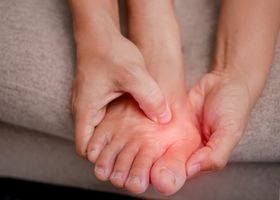Bunions vs. Bone Spurs: Differences & Similarities
Updated December 19, 2024

Bunions and symptoms associated with this condition are reported by 1 out of every 3 Americans. A bunion is a bony bump developing at the base of the big toe, which can be seen on the inner side of the foot. Inflammation of the fluid-filled sac around the toe joint leads to pain, and in some cases, redness can be seen around the area. In most cases, bunions are not dangerous to your overall health but can progress into severe pain and deformity if left unmanaged.
A smaller bunion is also known as a tailor's bunion and can develop in the joint of your little toe. Early signs of bunions consist of the typical bony bump forming at the joint of the big toe accompanied by stiffness, swelling, and pain in the area. Calluses may also form on the inner edge of the bunion.
What Is a Bone Spur?
A spur is an outgrowth that usually develops at the edge of a bone due to repeated stress applied to the structure. Bone spurs can occur across all joints in the body, including the big toe and calcaneus bone. Heel spurs are one of the most common forms of bone spurs and should not be confused with plantar fasciitis.
Bone spurs can be caused by degenerative joint conditions like osteoarthritis and rheumatoid arthritis. A bone spur of a large enough size will compress the tissue around the affected joint, causing pain and inflammation. It usually develops without you knowing about it, eventually growing to a size where it protrudes into the tissue around the spur.
Pain accompanying a bone spur has been described as a dull ache in the area around the bone spur and a sharp pain when placing weight onto the foot in the morning. People with bone spurs have also reported stiffness and numbness.
Comparing Bunions and Bone Spurs
The main similarity between bone spurs and bunions is the development of a bony lump in a particular area of the foot. With bunions, this bony lump is visible at the base of the big toe, while bone spurs develop internally and apply pressure to soft tissue structures within the foot. These conditions are not severe and usually don’t cause symptoms in most people.
From the early stages of bunion development, you will be able to see the joint of the big toe becoming slightly enlarged and inflamed. You will also notice the slow development of the bunion as the big toe becomes angled towards the smaller toes.
Bone spurs usually grow larger without you being aware that the bone spur is developing. The bone spur will eventually reach a size where it will protrude into the tissue, aggravating the tissue with repeated walking or running. Bone spurs can occur in any joint in the body, including on the underside of the heel bone or calcaneus.
Treatments for Bunions and Bone Spurs
For both conditions, you can apply ice to painful areas to relieve symptoms of inflammation and pain. Rest will further allow inflammation in the area to subside without aggravating the joint or tissue around the spur again. For both conditions, weight loss will reduce the amount of force placed on the inflamed tissue and can help you relieve pain.
Medication can provide relief from pain and inflammation that arise from the progression of both disorders. Non-steroidal anti-inflammatory drugs can help relieve these symptoms.
Treating Bunions
In combination with exercises for bunions, you can use orthotics for bunions to effectively manage the progression of bunion formation and even correct bunions without surgery. Bunion pads and custom footwear will be beneficial in alleviating the pressure placed on the forefoot and toe. Ensure that you are wearing footwear that is wide enough to allow space for the toes and forefoot. Shoes with a small toe box and a hard sole may aggravate symptoms associated with bunions.
Treating Bone Spurs
Treatment for bone spurs includes a combination of exercise, orthotics, and medication to manage pain and inflammation. The soft tissue around the bone spur is prone to inflammation, so symptoms can be reduced by limiting the pressure put onto the tissue around the spur.
You can experience a drastic reduction in symptoms with the correct custom orthotics that adequately relieve pressure around the area of tissue surrounding the inflamed structure. Orthotics are a cost-effective way to manage this and are interchangeable between shoes.
In severe cases of bone spurs, an arrangement of conservative treatment options may not be able to provide enough pain relief to carry out your daily activities in a pain-free manner. In cases where all conservative treatments have failed, a medical professional may suggest surgery to remove the bone spur entirely. It may take some time for you to fully recover after that, with the doctor usually recommending a period off your feet and time in a supportive walking boot.
With bigger bone spurs, the doctor may recommend using crutches and a longer period in a boot, perhaps as much as 2–4 weeks. You can usually return to exercise and sport three months after the surgery, but this will depend on your surgeon.
For both conditions, if you are experiencing any symptoms that are disabling or reducing your ability to walk, it is advised that you seek advice from a medical professional.








